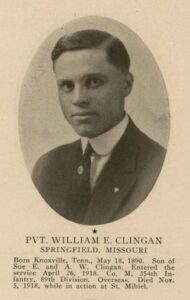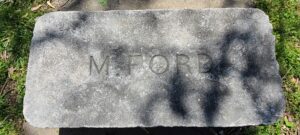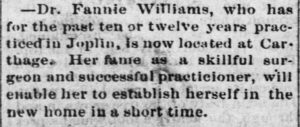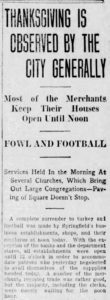
William Ellis Clingan
Did you know there is a World War I memorial in Springfield? The memorial was placed in Grant Beach Park in 1924 and contains the names of 66 local soldiers who died during the war. It was dedicated on November 11, on the sixth anniversary of the armistice that ended World War I. This is the first in a series about the Ozarks in World War I, particularly the men and women who served. We’ll meet the men on the monument, Red Cross Nurses, and much more. Let’s begin with William Clingan.
World War I began on July 28, 1914, when Austria-Hungary declared war on Serbia. The United States entered the war on April 6, 1917. Hundreds of men from the Ozarks enlisted in the armed forces, including William Ellis Clingan of Springfield.
Ellis, as he was known, was born in Knoxville, Tennessee, though the family lived in Springfield by 1903, in a house that once stood at the northwest corner of Kansas Avenue Nichols Street. One of four children of Adonijah and Sue, he was a tall, slender man, with gray eyes and dark hair. He had a brother, Eugene, a sister, Iva, and a twin sister, Ella. The family was active in the community and often held parties at their home that were noted in local newspapers. Iva and Ella were teachers; Eugene was a fireman. Ellis worked as a blacksmith.
Just over one month after the US entered the war, the Selective Service Act was passed, requiring all males between 21-30 to register. Ellis registered on June 5th; it wasn’t until April 1918 that he enlisted and was sent to Camp Funston for training. He was eventually assigned to Company M, 354th Infantry, and left for Europe out of Montreal, Canada, aboard the transport ship Ascamus.
In a letter to his mother the following October, he reported having spent several days in “the front trenches,” and had “made several trips across No Man’s Land…in the midst of heavy firing.” Ellis died November 1, 1918 after being struck in the head by a machine gun bullet. (Military records show his death as November 1st, not November 5th as is shown in the above image.)
Originally buried in the American Cemetery at Barricourt, in June 1919, Ellis was disinterred and reburied at the Meuse-Argonne American Cemetery.





